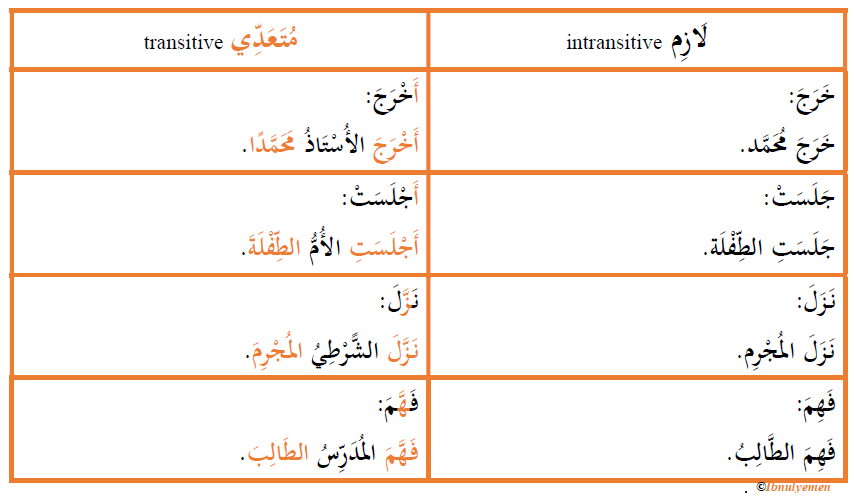Arabic Verb Forms [Transitive vs. Intransitive] Posted by Ibnulyemen اِبْنُ اليَمَن on Aug 10, 2017 in Grammar, Vocabulary
We use the language to share our feelings and thoughts. This entails expressing a state of being or an action. In Arabic, the latter is done using a verbal sentence. As the name suggests, it should contain a verb; plus, it, the verb, must occur sentence-initially. To make sense, it is essential that we know whether the verb requires an object (i.e. intransitive لَازِم laazim) or not (i.e. transitive مُتَعَدِّي muta‘addii).

What is intransitive لَازِم?
Put simply, an intransitive verb is a verb that does not require an object. For instance, the English sentences (1) and (2) are completely meaningful without an object, and so is the case with the corresponding Arabic ones.
(1) John laughed. ضَحِكَ جُوْن. DaHika John.
(2) Sally is crying. تَبْكِي سَالِي. tabkii Sally.
What is a transitive مُتَعَدِي?
It basically is the opposite; that is, the sentence is not meaningful unless an object is added. For example, the English sentences (3) and (4) do not make a complete sense, and so are the respective Arabic translations.
(3) Jack hit. ضَرَبَ جَاك. Daraba Jack.
(4) Samar is throwing. سَمَر تَرْمِي. Samar tarmii.
To make them meaningful, an object must complement the verb, as is in (5) and (6).
(5) Jack hit Sarah. ضَرَبَ جَاك سَارَة. Daraba Jack Sarah.
(6) Samar is throwing a bottle. سَمَر تَرْمِي قَارُوْرَة. Samar tarmii qaaruurah.
Hence, ضَحِكَ and تَبْكِي are intransitive verbs, while ضَرَبَ and تَرْمِي are transitive. Hmm! How do we know what is what? Well, this is oftentimes implied in the meaning of verbs. Furthermore, intransitives normally express behavior, appearance, mood, or condition. However, it is important to know that an intransitive can be made transitive, but not the other way round.
How to change an intransitive verb into a transitive?
There are three ways to do this:
a) by means of a prefix, namely أ, as in the table above and in (7), (8), and (9). The intransitive verbs ضَحِكَ, بكَى, and فَرِحَ become transitive after adding أ hamzah to the beginning to form أَضَحَك, أَبْكَى, and أَفْرَحَ, ‘make laugh’, ‘make cry’, and ‘make happy’, respectively.
(7) أَضْحَكَ جُوْن سَارَة. aDhHaka John Sarah ‘John made Sarah laugh.’
(8) أَبْكَى جَاك سَالِي. Abkaa Jack Sally. ‘Jack made Sally cry.’
(9) أَفْرَحَ خَالِد صَدِيْقَتَهُ. afraHa Khalid Sadiiqatahu ‘Khalid made his girlfriend happy.’
b) using an infix (i.e. an addition inserted within the verb), namely ّ on the middle letter, as in (10), (11), and (12). After doubling the middle letter,ضَحِكَ , بَكَى, and فَرِحَ become transitive.
(10) ضَحَّكَ جُوْن سَارَة. DhaHHaka John Sarah. ‘John made Sarah laugh.’
(11) بَكَّى جَاك سَالِي. bakkaa Jack Sally. ‘Jack made Sally cry.’
(12) فَرَّحَ خَالِد صَدِيْقَتَهُ. farraHa Khalid Sadiiqatahu ‘Khalid made his girlfriend happy.’
c) by adding ا after the first letter of the tri-consonantal verbs, as in (13) and (14):
(13) intransitive: جَلَسَ صَالِح. Jalasa SaaliH. ‘Saleh Sat.’
transitive: جَالَسَ صَالِح سَلِيْم. Jaalasa SaaliH Saliim ‘Saleh Sat with Salim.’
(14) intransitive: لَعِبَ الوَلَد. la‘iba al-walad ‘the boy played.’
transitive: لَاعَبَ الوَلَد البِنْت. la‘aba al-walad al-bint ‘the boy played with the girl.’
Seemingly, أ and ّ are used with pretty much the same meaning. However, this is not the case; rather, the insertion of ّ on the middle letters signifies repetitiveness in the action; e.g., ضَحَّكَ ‘make somebody laugh’ means the action of laughing was done repetitively, and so is the case with بَكَّى and فَرَّحَ in (11) and (12), respectively.
As for the addition of ا after the second letter, as in (c), it always means participatory roles in performing the action. That is, the action is done by both persons/things involved in the sentence.
As to the transitive, it is also further divided into mono-transitive, requiring one object, ditransitive, requiring two, and tri-transitive, requiring three. This is something to expound further in future posts.
Exercise:
Make these intransitive verbs intransitive in at least two ways. Use your dictionary for help. Also, attempt to use them in sentences. Answers will be posted on our Facebook Page 24 hours later.
رَجَعَ قَعَدَ عَلِمَ شَبِعَ وَقَفَ رَقَدَ رَقَصَ

Build vocabulary, practice pronunciation, and more with Transparent Language Online. Available anytime, anywhere, on any device.



